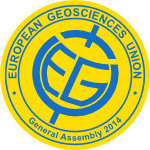 The last two days of the conference were packed with geomagnetism related sessions. I had to leave my blogging and Earth Scientist self behind and fully embrace the wide range of talks and posters directly relevant and important to my own research. I’ve decided to merge my last two diary entries; whilst a lot of the science was very interesting to myself, I appreciate that reading about the mathematical theory of the geomagnetic field doesn’t offer the light relief Dan and I seek to provide in the content of this blog! This post is packed with sediments, some thoughts on presenting my own research and volcanoes!
The last two days of the conference were packed with geomagnetism related sessions. I had to leave my blogging and Earth Scientist self behind and fully embrace the wide range of talks and posters directly relevant and important to my own research. I’ve decided to merge my last two diary entries; whilst a lot of the science was very interesting to myself, I appreciate that reading about the mathematical theory of the geomagnetic field doesn’t offer the light relief Dan and I seek to provide in the content of this blog! This post is packed with sediments, some thoughts on presenting my own research and volcanoes!
Sediments as recorders of the Earth’s Magnetic Field
Thursday was dominated by the session I was presenting in, EMRP3.2: Multi-faceted Palaeomagnetism and Rock Magnetism: A Tribute to Reidar Løvlie. The early morning oral sessions focused on how we can better understand how sediments record the signature of the magnetic field, which was the area of expertise of the late Løvlie. The mechanism by which the Earth’s magnetic field is recorded in sediments is called Detrial Remenant Magentisation (DRM for short): it results from the alignment of magnetic minerals (as they fall through the water column of a lake or marine environment), in the direction of geomagnetic field present at the time. The magnetisation is not fully acquired until the sediment has been compacted and consolidated. Subsequent disturbance of the sediment by bioturbation or realignment of magnetic particles in the pore space, can give rise to a post-depositional remanent magnetisation (PDRM). The oral presentations highlighted how critical it is to improve our understanding of factors such as having a good geochronological handle on the ages of the sediments and inclination shallowing to fully understand the process by which sediments record magnetisation.
Presenting my own research
I was surprisingly nervous when it came to presenting my own research during the poster session. There were a lot of experts in the field at the conference and I was feeling the pressure of exhibiting my research accurately and in detail. It helped that there were a few familiar faces that came to lend support and people who came to talk to me seemed genuinely interested and keen to learn more. I had a few discussions with people who challenged my way of thinking, but that was a hugely positive thing. It made me look at my work in a new light. Every scientist will tell you, you get so close that it is easy to loose perspective and sight of what the key questions are and how you might improve your own work, or that there may be a new avenue or direction ripe for exploration! Despite my initial nerves, I thought the session went well. I felt I communicated the key points I was trying to make in the poster to those whom I spoke to and I got some valuable suggestions of ways I could improve my work. Overall, a success!!!
A multidisciplinary approach
Rocks aren’t the only reliable recorders of the ancient signature of the Earth’s magnetic field. It turns out that archaeological materials that have been fired (say clay pots, building blocks used in the construction of ancient palaces, etc…) are excellent materials that we can use to study Earth’s magnetic field. My office mate and friend, Megan Thomas, explains the process involved in this excellent post.

Section of mural work on the Government Palace in Tlalpan depicting the eruption of the Xitle volcano.
Source: WikiCommons. Author: Alejandro Linares Garcia
Much of the last day of the conference was taken up by sessions that covered archaeomagnetism and how it can be used not only to understand the geomagnetic field, but also resolve geological conundrums. For example, archaeomagentism was used to date the timing of the eruption of the Xitle Volcano in Mexico. Is Cuicuilco the Pompeii of Mesoamerica? Is the downfall of the civilisation at the ancient settlement a direct result of the eruption of Xitle Volcano? Radiocabon dating of wood fragments at the base of the lava flows suggest that the eruption is younger than the age at which the city is thought to have been abandoned. New results for the strength of the magnetic field (the field intensity), as obtained from the lava flows that burry the city; suggest that the lava flows are older than the published radio carbon dates. This conclusion results from comparison of the intensity results from the lava flows to the field models available. It turns out, Cuicuilco is the Pompeii of Mexico! (If you want to read about this research in more detail, take a look at Alva, EPS, 57, 839-853, 2005 for a review and the EGU 2014 conference abstract).


